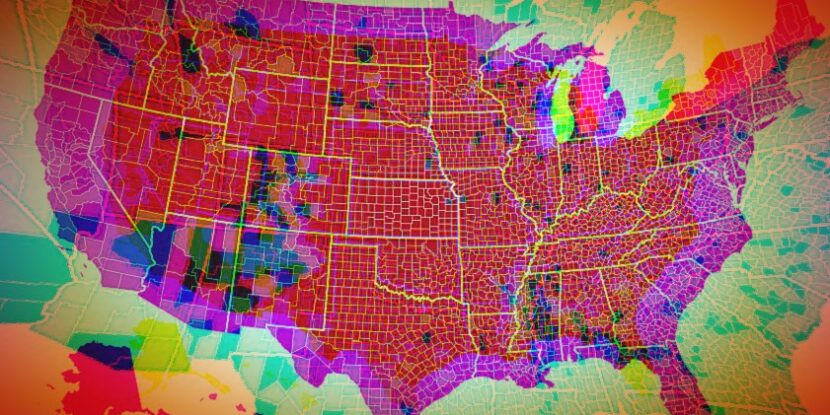The 2020 Census process is already underway, and the popular elections website 270toWin.com is predicting major changes to the way 17 states are represented in the Electoral College and in Congress. So who wins?
HOW IT WORKS.
The U.S. House of Representatives has been capped at 435 members since 1929. State representation in the House is allocated based on population. Since the number of members is capped, if one state gains a seat, another state must lose one. The Electoral College corresponds to the 435 U.S. House districts and 100 U.S. Senate seats, plus three electoral votes for the District of Columbia, for a total of 538 electoral votes. Washington, D.C. does not have any representation in Congress, but the 23rd Amendment was ratified in 1961 to grant it as many electoral votes as the least-populated state, which means it has three votes.
270toWin.com used recent estimate data to project how representation will change in the House of Representatives and Electoral College, barring a sudden and drastic population-changing event. Although the census will be conducted in 2020, redistricting won’t happen until 2021, so this year’s elections will be conducted under the current apportionment. The changes will take effect beginning in the 2022 midterm elections.
WINNERS AND LOSERS.
270toWin.com projects the following 7 states will gain seats in the House and votes in the Electoral College:
Texas +3 Total: 41 electoral votes, 39 House seats
Florida +2 Total: 31 electoral votes, 29 House seats
Arizona +1 Total: 12 electoral votes, 10 House seats
Colorado +1 Total: 10 electoral votes, 8 House seats
Montana +1 Total: 4 electoral votes, 2 House seats
North Carolina +1 Total: 16 electoral votes, 14 House seats
Oregon +1 Total: 8 electoral votes, 6 House seats
The website also projects the following 10 states will lose seats in the House and votes in the Electoral College:
Alabama -1 8 electoral votes, 6 House seats
California -1 54 electoral votes, 52 House seats
Illinois -1 19 electoral votes, 17 House seats
Michigan -1 15 electoral votes, 13 House seats
Minnesota -1 9 electoral votes, 7 House seats
New York -1 28 electoral votes, 26 House seats
Ohio -1 17 electoral votes, 15 House seats
Pennsylvania -1 19 electoral votes, 17 House seats
Rhode Island -1 3 electoral votes, 1 House seat
West Virginia -1 4 electoral votes, 2 House seats
The new numbers show people leaving the more populous blue states of California, Illinois, and New York in favor of the red state of Texas and the leans-red state of Florida. Those high tax, low quality-of-living blue states struggle to compete with the business and family-friendly cultures in Texas and Florida.
BEHIND THE CHANGES TO AMERICA.
There’s plenty of growth in the West too. In Colorado, the Denver area has exploded over the last decade (and caused the state to drift farther to the left). In Montana, the population has cracked one million for the first time as its extraordinary natural beauty attracts more full-time residents. In Arizona, the Phoenix area is growing, as are sunny communities around the state popular with retirees. And in Oregon, Portland has become a hip haven for left-leaning types, although population growth slowed at the end of the decade.
Aside from the losses in the big three leftist states, Appalachian states are continuing to feel the pain of the decline of American manufacturing and heavy industry.
Northeast Ohio has continued to lose population, especially in the Cleveland-Akron area, though there have been some signs of stabilization in recent years.
Pennsylvania’s population declines were concentrated in the industrial parts of the state, mainly northern and western Pennsylvania. Coal industry decline and the opioid crisis have devastated West Virginia. Michigan is more of a mixed bag, because it has actually grown for seven straight years, but it wasn’t enough to offset losses from the recession at the beginning of the last decade, caused in part by the failures of the Big Three carmakers (Ford, GM, and Chrysler).
Rural areas and small cities in Alabama have been losing population for some time. Leftist policies from Democrats in Minnesota led many rural residents to flee the state for more friendly climates in neighboring Midwestern states.
2020 MATTERS FOR 2021.
The new Electoral College map would, on first glance, appear to benefit Republicans with most gains in traditionally red states and some losses in traditionally blue states.
In fact, if the projected 2024 map was in place in 2016, the GOP would have gained an additional 5 electoral votes. But we all know how expectations of red states and blue states can be upended, and a lot, politically, will change before 2024.
Congressional representation will also be affected by who controls the redistricting process in each state.
In many states, the party that controls the state legislature in 2021 will be able to draw itself a more friendly congressional map.
It’s another reason why the 2020 elections will be critical, not just because of the presidential race but elections up and down the ballot.


